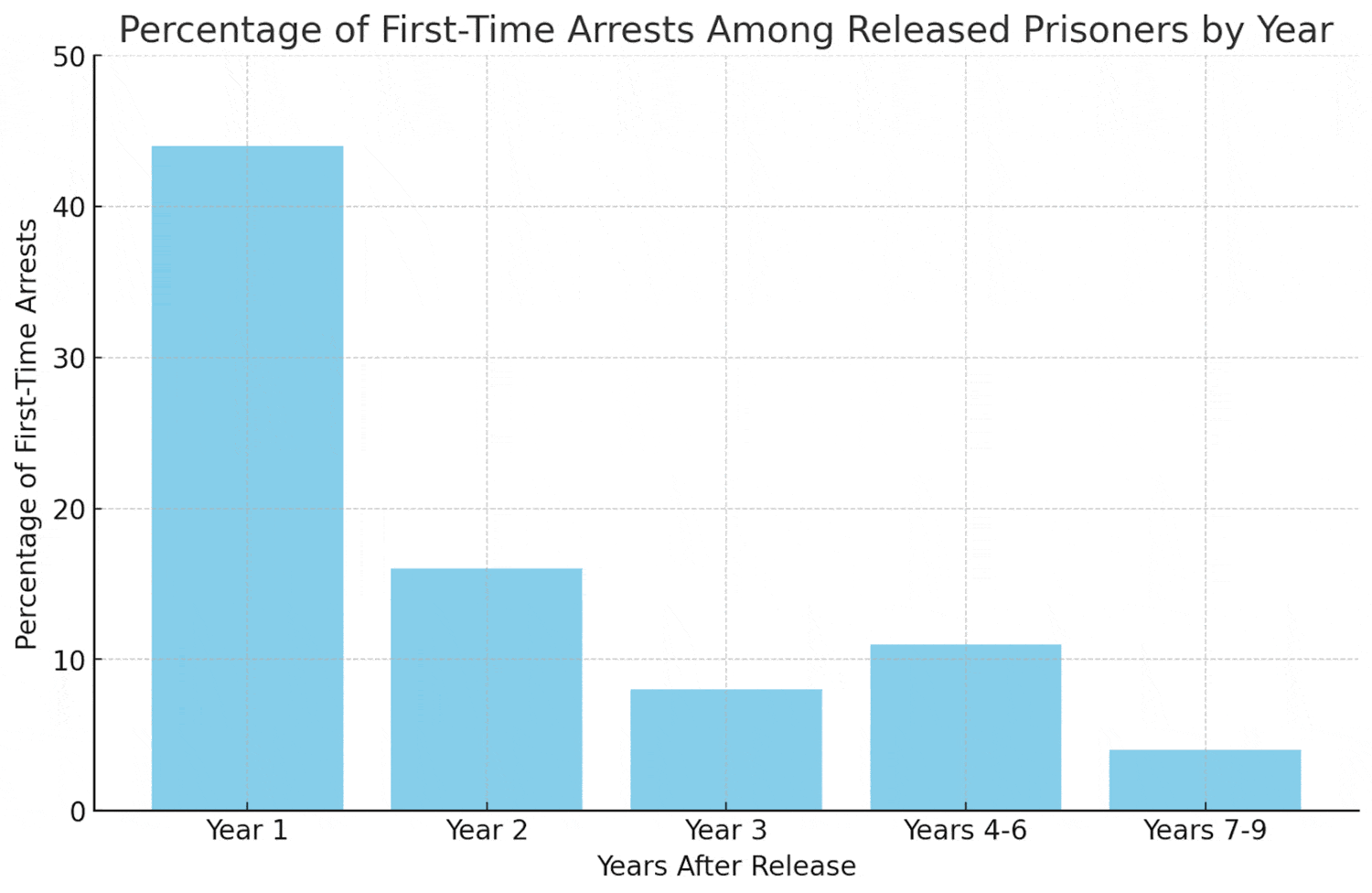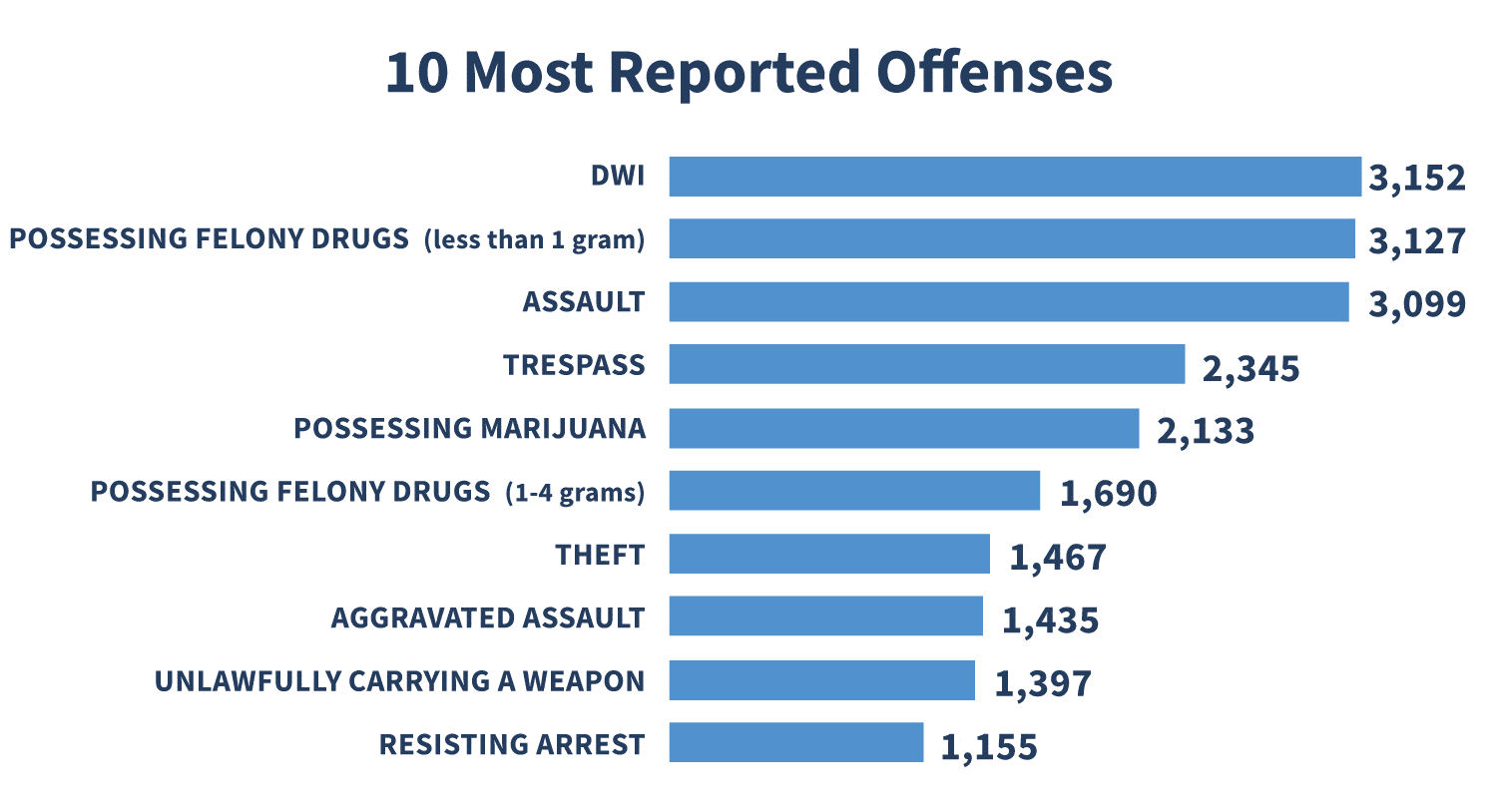
Recidivism, Reentry and Criminal Justice Reform in Texas
Examining why people become repeat offenders and what can be done to help them successfully reintegrate after their release
In Texas and throughout the United States, recidivism is a serious concern, presenting significant challenges for those facing convictions, as well as for their families and society as a whole.
This issue not only impacts the stability and well-being of individuals and communities but also places a considerable strain on the legal and correctional systems. Effective strategies to reduce recidivism are essential for fostering safer communities and ensuring that individuals have the opportunity for rehabilitation and reintegration.
This article will explore the factors that lead to recidivism and the steps that can be taken to help individuals become productive members of their communities upon their release.
What is recidivism?
A repeat offender, also known as a recidivist, is an individual who repeatedly commits crimes and is convicted multiple times. The term “recidivism” is used to describe the act of a person reoffending, especially in the context of criminal behavior and subsequent convictions.
Recidivism rates are often used as a measure of the effectiveness of criminal justice systems, rehabilitation programs, and other interventions aimed at preventing crime.
U.S. recidivism rate
- U.S.: 70%
- Norway: 20%
Source: Recidivism Rates in the United States versus Europe: How and Why are they Different?
According to a 9-year study by the U.S. Department of Justice (DOJ) published in 2018 that reviewed recidivism rates across 30 states, including Texas, approximately 68% of people released from prison were rearrested within 3 years. That number increased to 79% within 6 years and a whopping 83% within 9 years.
The study also found that the 401,288 released from prison in 2005 were estimated to have been rearrested almost 2 million times over the following 9 years. That averages out to about 5 arrests per prisoner released during that period.

While these numbers are understandably discouraging, they also show us that many criminals who end up getting rearrested manage to avoid a second arrest for at least one year (and sometimes many years) after their release.
This means there are opportunities to provide additional assistance during this time that could potentially prevent reoffending. By identifying the key factors that contribute to a criminal’s ability to stay arrest-free for a period, we can develop targeted interventions and support systems to keep more individuals from reentering the criminal justice system.
What is the current recidivism rate in Texas?
National average
68%
Texas
20.3%
On average, about 70,000 people are released from the Texas Department of Criminal Justice (TDCJ) each year.
According to the TDCJ’s 2022 Biennial Reentry and Reintegration Services Report, the Texas inmate population maintains one of the lowest recidivism rates in the United States, with an overall rate of only 20.3% within 3 years after release from prison.
This is significantly lower than the national rate of 68%. However, the highest recidivism rates in Texas are observed in cases involving state jail felonies, where 63% of individuals are rearrested within a 3-year period.
State jail felonies:
These could include crimes like certain drug offenses, property theft of a certain value, and other non-violent offenses. The higher recidivism rate here might indicate that individuals convicted of these types of crimes are more likely to reoffend or be rearrested compared to those convicted of other types of crimes.
Which crime has the highest recidivism rate?
Property crimes typically have the highest recidivism rates compared to other types of offenses. This category includes crimes like larceny, theft, motor vehicle theft, arson, shoplifting and vandalism.
According to the DOJ, approximately 51% of people who served time for a property crime were rearrested within the first year after their release. Factors contributing to the high recidivism rate for property crimes include the often opportunistic nature of these offenses, economic motivations, and sometimes the involvement of substance abuse issues.
10 biggest mistakes to avoid in your Texas criminal case
Are you facing criminal charges? Protect your rights after by avoiding these common mistakes.
Texas Department of Criminal Justice (TDCJ)
Number of
prisons: 104
Prisoner
population: Over 145,000 offenders
Daily maintenance
cost per prisoner:
$61.63
Background of
offenders:
A majority come from broken homes.
Substance abuse
and addiction:
Approximately 59% of offenders struggle with these issues.
Annual release
rate:
TDCJ releases approximately 70,000 offenders each year.
Mentor training program:
To aid these offenders in overcoming the challenges they face upon reentering society, TDCJ has implemented a mentor training program. This program focuses on providing guidance and support to help former offenders reintegrate successfully, reducing the likelihood of recidivism.
Source: Texas Department of Criminal Justice, Rehabilitation Programs Division
As reported by the Public Safety Report System (PSRS) based on 215,836 completed bail forms as of August 31, 2022:
TYPES OF OFFENSES
Class A misdemeanors
27%
Class B misdemeanors
24%
Third degree felonies
18%
State jail
felonies
17%
MOST REPORTED OFFENSES
DWI
(driving while intoxicated)
3,152
Drug possession
(less than 1 gram)
3, 127
Assault causing
bodily injury
3,099

Misdemeanors versus felonies: Understanding Texas classifications of criminal offenses
Explore the key differences between misdemeanors and felonies in Texas. This comprehensive guide delves into the state’s legal classifications of criminal offenses, helping you understand the varying degrees of severity and their potential legal consequences.
Top 10 states with highest population of prisoners in 2021
| State | Total | Male | Female | Approx. population | Incarceration rates
per 100,000 residents |
|---|---|---|---|---|---|
| Texas | 133,772 | 123,263 | 10,509 | 29 M | 461.28 |
| California | 101,441 | 97,525 | 3,916 | 39 M | 260.11 |
| Florida | 80,417 | 75,404 | 5,013 | 21.5 M | 374.03 |
| Georgia | 47,010 | 43,942 | 3,068 | 10.7 M | 439.35 |
| Ohio | 45,029 | 41,443 | 3,586 | 11.7 M | 384.86 |
| Pennsylvania | 37,194 | 35,182 | 2,012 | 12.8 M | 290.58 |
| New York | 30,338 | 29,233 | 1,105 | 19 M | 159.67 |
| Illinois | 28,475 | 27,165 | 1,310 | 12.6 M | 225.99 |
| Arizona | 33,914 | 30,794 | 3,120 | 7 M | 484.49 |
| Michigan | 32,186 | 30,621 | 1,565 | 10 M | 321.86 |
Source: U.S. Department of Justice, Office of Justice Programs, Bureau of Justice Statistics
Several factors that affect incarceration rates include:
- Population size: Texas, California, and Florida are among the most populous states in the U.S.
- Crime rates
- Criminal justice policies
- Law enforcement practices
- Socio-economic factors
- Racial and ethnic disparities
- Legal representation and judicial discretion
It’s important to note that these factors are interconnected, and their impact varies from state to state.
Why do criminals become repeat offenders?
Formerly incarcerated people reoffend for a variety of reasons, often influenced by a complex mix of personal, social and systemic factors.
One of the most significant issues leading to rearrest is often related to employment. Finding employment with a criminal record can be challenging, and unemployment or underemployment leads to financial strain, which may push some individuals back into criminal activities.
Other key reasons include the following:
- Lack of support and resources. Upon release, many ex-offenders find themselves without adequate support, be it financial, emotional or social. This lack of support can make it difficult to reintegrate into society successfully.
- Substance abuse and mental health issues. Unaddressed substance abuse problems and mental health issues can contribute to recidivism. Without proper treatment and support, individuals may revert to criminal behavior as a coping mechanism.
- Social and environmental factors. The environment to which individuals return can play a significant role. Returning to the same community or social circle where criminal behavior is normalized can increase the likelihood of reoffending.
- Inadequate rehabilitation programs. If the incarceration period does not include effective rehabilitation programs, individuals might not develop the skills or mindset needed to avoid criminal behavior after release.
- Systemic issues and stigma. Systemic issues such as poverty, lack of education, and societal stigma against ex-offenders can create barriers that make lawful reintegration difficult.
- Habitual criminal behavior. For some, criminal behavior is a learned pattern or lifestyle. Breaking these established patterns without proper guidance and support can be extremely difficult.
- Lack of positive role models or mentors. Without positive influences or mentors, individuals may struggle to find lawful and productive pathways in life.
- Inadequate transition planning. Poorly planned transitions from prison to the community, without ensuring access to essential services and support, can leave individuals vulnerable to reoffending.
- Conditioning to institutional life. Long-term incarceration can lead to institutionalization, where individuals become accustomed to life inside the prison system and struggle to adjust to life outside.
Understanding and addressing these factors is crucial for developing effective strategies to reduce recidivism and support ex-offenders in their transition back into society.
Life after prison: Finding employment after incarceration
Finding employment can be difficult even without a criminal record. Understand your rights and learn what to do when applying for a job to increase your chance of success.
Why does Texas have a low recidivism rate?
Texas’s relatively low recidivism rate can be attributed to a combination of groups and initiatives focused on the rehabilitation and reintegration of offenders into society.
The Reentry Task Force in Texas operates through several working groups and councils, each targeting specific reentry challenges. These groups work collaboratively to develop and implement strategies addressing various barriers, with the ultimate goal of reducing recidivism rates in Texas.
Key groups and their functions include:
- Statewide Behavioral Health Coordinating Council. This council is responsible for creating and overseeing the Texas Statewide Behavioral Health Strategic Plan. The plan focuses on addressing gaps in behavioral health services and systems.
- Joint Committee on Access to Forensic Services. This committee provides recommendations on access to forensic services in Texas, drawing on input from consumers, stakeholders and the health and human services system.
- Texas Coordinating Council for Veteran Services. Aimed at assisting veterans, service members and their families, this council coordinates the activities of state agencies and enhances outreach efforts. It also fosters collaborative relationships to address issues affecting these groups.
- Texas Interagency Council for the Homeless. Tasked with coordinating services for the homeless, this council surveys existing resources, assists in service provision statewide, increases information flow among providers, and offers technical assistance for housing needs assessment.
- Employment Working Group. Focusing on post-release employment, this group identifies strategies to overcome employment barriers, coordinates resources, and provides job training and assistance. It also contributes to the Mapping the Future grant project, aiming to identify and address gaps in TDCJ’s reentry system.
The Texas Department of Criminal Justice – Rehabilitation and Integration Division (TDCJ-RID), alongside these councils and working groups, has been instrumental in enhancing reentry services that reduce recidivism and support reintegration.
How Texas’s Reentry Program works to reintegrate offenders and reduce recidivism rates
The TDCJ’s Reentry and Integration Division currently has a 3-phase program in place aimed at equipping offenders with the necessary skills and preparation for successful reintegration into the community following their release from prison.
Phase I
The first phase of the program includes a reentry case manager who assists eligible inmates. If needed, they can help inmates order IDs, such as birth certificates, military service records, replacement social security cards or a DPS ID card.
These case managers can also help inmates obtain any technical or career certification certificates earned during lockup and are working toward assisting inmates in renewing driver’s licenses, including commercial driver’s licenses. Having these documents upon release from prison allows inmates to more easily secure employment, state benefits and housing as they reintegrate into the community.
Phase II
In the second phase, a risk assessment for parole is conducted by the reentry case manager. This assessment determines the inmates’ risk of reoffending.
People who score moderate or high are given individualized case planning, which sets goals and actionable steps to address their needs and explains available resources so that inmates can experience a successful return to the community.
Phase III
The third phase puts a heavy emphasis on employment for the inmate. Case managers assist with the employment search and job interview preparation and help inmates obtain basic necessities and housing.
Much emphasis has been placed on Phase III by the TDCJ and other official state organizations to assist inmates with securing employment, as employment has been closely tied to reduced recidivism rates.
Recent changes to Texas’s bail law
Senate Bill 6, also known as the “Damon Allen Act,” was a significant legislative reform of Texas’s bail system, passed during the 87th Legislature’s Second Called Session. Named in honor of Trooper Damon Allen, who was killed in the line of duty, the act aimed to address concerns about the release of potentially dangerous individuals on bail.
This bill marked the first major overhaul of the state’s bail system since the 19th century. Key elements of S.B. 6 include the following:
- Establishment of a public safety report system. The bill requires the Office of Court Administration (OCA) to implement a standardized system for evaluating the risk of individuals who are seeking bail. This system is meant to be used by magistrates when deciding bail amounts and conditions.
- Restrictions on personal bonds. The act prohibits the release of defendants on personal bonds if they are charged with violent or sexual offenses to prevent the release of high-risk individuals who might pose a danger to the public.
- Judicial education. It mandated additional training requirements for magistrates, focusing on issues relevant to bail setting.
- Certification and reporting for charitable bail organizations. The bill set specific certification and reporting requirements for charitable organizations involved in posting bail.
- Amendments to cash bail bonds. It also made amendments to the procedures regarding cash bail bonds.
Additionally, a person who is arrested must be brought before a magistrate within 48 hours of the arrest, and all defendants at those hearings are entitled to an attorney, even on weekends.
The criminal defense guide
to bail & bonds
Get answers to the most frequently asked questions about bond amounts and conditions in Texas.
Committee formed to evaluate Texas’s criminal justice reform policies
The state of Texas has been working to reform its criminal justice system in recent years. The major bail reform law in 2021 created a need to determine if additional legislation was needed to “ensure Texans are protected from the most dangerous criminals while ensuring the constitutional rights of defendants.”
To accomplish this, Texas House Speaker Dade Phelan established the House Interim Study Committee on Criminal Justice Reform on March 10, 2022. The purpose of this committee was to scrutinize various aspects of Texas’s criminal justice policies, focusing on both the intake and outcomes within the system, with the aim of upholding public safety and Texans’ right to due process.
The committee focused on 2 main charges:
- Monitoring the implementation of Senate Bill 6. This involved overseeing the execution of changes to the state’s bail system, as outlined in S.B. 6, passed by the 87th Legislature. The goal was to determine if further legislation is required to balance protecting Texans from dangerous criminals and respecting the constitutional rights of defendants.
- Examining various criminal justice policies. This examination covered a broad range of areas, including:
- Policing practices encompassing aspects like officer training, the application of force, procedures for making arrests, and alternative approaches to handling nonviolent and noncriminal situations.
- The entire spectrum of criminal procedures and due process, from detention to appeal. This included drug offense policies, prosecutorial discretion, detention and incarceration conditions, civil asset forfeiture, and jury and sentencing practices in felony cases.
- Transparency levels in policing and prosecution, including the grand jury process.
- The juvenile justice system, including the appropriate age range for juvenile offenders, parole eligibility, and procedures for juveniles tried as adults.
- Strategies to reduce recidivism and eliminate obstacles that hinder successful reintegration into society post-incarceration.
The committee’s work was aimed at evaluating and enhancing the effectiveness and fairness of the criminal justice system in Texas.
Do I need a lawyer for
a police interview?
Learn about your right to an attorney and why you should insist on one before being questioned by police.
Findings from the committee to reduce recidivism in Texas
In January 2023, the Committee on Criminal Justice Reform released a detailed report on the state’s efforts to overhaul the criminal justice system, pointing out that beyond impacting ex-cons themselves, recidivism can impact society in a variety of ways, including drug addiction, homelessness and public safety.
Included in its findings were factors that lead to an ex-con’s successful reentry into society.
So, what factors prevent recidivism?
These factors included:
- The ability to find gainful employment
- Permanent and stable housing
- A means of transportation
- Treatment for substance abuse, mental health and medical needs
The report states that the most important predictor of an ex-con’s successful reentry into society is employment. They single out the employers’ ability to offer these people a second chance despite their ex-con status.
“Many business leaders recognize the importance of second chance hiring; benefits include finding untapped qualified talent, solutions to ongoing labor shortages, alleviating economic pressures, and ultimately helping reintegrate Texans back into society. That being said, businesses have also voiced concerns relating to liability issues and regulatory requirements.”
The report goes on to explain that the strong correlation between successful reintegration into society and employment has renewed a push to “ban the box” on job applications. Employers are encouraged to remove the checkmark for criminal history on their applications and delay background checks until much later in the hiring process so they can consider the person’s qualifications first.
One recommendation by the panel was for the Texas Legislature to pass the proposed “Clean Slate” law, which would allow for automated clearance of records for those persons eligible to have their records sealed. Currently, in Texas, an individual with a first-time, non-serious misdemeanor is qualified to have their record sealed. The panel points out that a rather involved process, which necessitates the hiring of an attorney and paying additional fees, is currently required to get records sealed.
Sealing your criminal record in Texas: Is it possible?
Learn when it is and isn’t possible to have your criminal record sealed in Texas.
FAQs
Q: Do repeat offenders get more time?
A: Yes, repeat offenders in Texas often receive longer sentences than first-time offenders for similar offenses. Texas law includes provisions for enhanced penalties for individuals with previous convictions. For example, if a person has two previous felony convictions, they could face a minimum sentence of 25 years for a third felony under certain conditions.
Prosecutors in Texas may also seek higher charges or be less inclined to offer plea deals to repeat offenders based on their prior criminal history. Additionally, judges often consider a defendant’s prior criminal record when determining sentences, so a history of previous offenses typically leads to harsher sentencing.
Because of this, legal representation is crucial for anyone facing criminal charges, especially those with prior convictions, to ensure their rights are protected.
Q: How long until a felony is off your record in Texas?
A: In Texas, a felony conviction generally remains on your record permanently and does not automatically get removed or “fall off” after a certain period. Unlike some states that have a process for expunging or sealing criminal records after a specified time, Texas has more restrictive laws regarding the removal of felony convictions.
However, there are a few circumstances under which a felony record might be cleared or sealed in Texas:
- Expunction. This completely erases the criminal record, as if the crime never occurred. In Texas, expunctions are typically available only in specific situations, such as when the charge was dismissed, the person was acquitted, or in cases of certain kinds of pardons.
- Order of nondisclosure. While not completely erasing the record, an order of nondisclosure can seal a criminal record from public view, making it inaccessible to certain private parties (like employers or landlords). However, orders of nondisclosure are not available for most serious felonies.
- Juvenile records. Different rules apply to juvenile records. In some cases, juvenile felony records can be sealed or expunged.
For most people convicted of a felony in Texas, the record will remain a part of their permanent criminal history. However, since laws can change, it’s always a good idea to consult with a legal expert for the most current information to explore any potential avenues for clearing or sealing a record based on individual circumstances.
Q: How do you beat a habitual felon charge in Texas?
A: Beating a habitual felon charge in Texas, like any criminal charge, involves navigating the legal system with a strong defense strategy. It’s crucial to have legal representation, as an attorney can provide guidance specific to the case’s circumstances and the nuances of Texas law.
Here are some general strategies that may be employed:
- Challenge the current charge. One approach is to contest the current felony charge itself. If the defense can raise sufficient doubt about the validity of the current charge, it negates the habitual felon enhancement.
- Question the validity of prior convictions. The defense can scrutinize the previous convictions that are being used to enhance the current charge. This could involve challenging the constitutionality of previous convictions, such as arguing that there was inadequate legal representation in earlier cases.
- Negotiate plea deals. Sometimes, it may be possible to negotiate with prosecutors to reduce the charges or to agree to a plea deal that avoids the habitual offender enhancement.
- Present mitigating factors. Demonstrating mitigating circumstances or showing evidence of rehabilitation, character, and other positive attributes may influence sentencing, even if the charge itself is upheld.
- Utilize procedural defenses. This involves looking for procedural errors or violations of rights that occurred either in the current case or in the cases leading to prior convictions.
- Show inaccurate or incomplete criminal record. Ensuring the accuracy of the criminal record is crucial, as records sometimes incorrectly include charges that were dismissed.
Each case is unique, and the applicable defense strategy depends on the specifics of the case. It’s essential for anyone facing a habitual felon charge to seek the assistance of an experienced criminal defense attorney who understands the complexities of the legal system and the specifics of habitual offender laws in Texas.
References
Alper, M., Durose, M., & Markman, J. (2018). Special Report 2018 Update on Prisoner Recidivism: A 9-Year Follow-up Period (2005-2014).
Interim Report to the 88th Texas Legislature House Committee on Criminal Justice Reform. (2023).
Texas Department of Criminal Justice. (2019). Reentry and Integration Division. Texas.gov.
Texas Department of Criminal Justice Biennial Reentry and Reintegration Services Report. (2022).
Texas Department of Criminal Justice, Rehabilitation Programs Division.
GRAPHS:
Data from August, 2022, via the Office of Court Administration of Texas.






